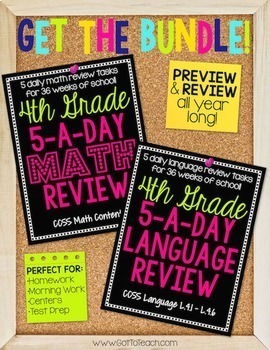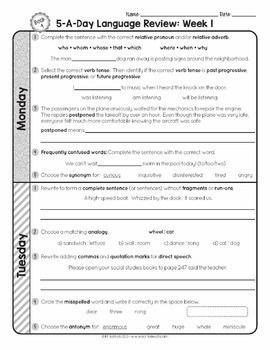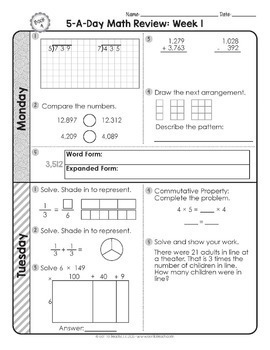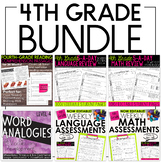4th Grade Daily Math and Language Spiral Review Bundle
- Zip
What educators are saying
Products in this Bundle (2)
Also included in
- This bundle includes my most popular fourth grade resources: math spiral review, math assessments, language and grammar spiral review, language and grammar assessments, reading comprehension passages for the entire year, and 3rd-grade work analogies. For a detailed overview of what's included, plePrice $58.23Original Price $90.99Save $32.76
Description
Daily Math and Language Reviews for the Entire School Year!
This spiral review is one of the easiest ways to make sure you are covering all of the important concepts that your students need to know. Perfect for morning work, “bell-ringers,” homework, center work, or test prep. This resource is designed to be used on a daily basis (Monday-Thursday) for up to 36 weeks. PREVIEW and REVIEW all year long!
The language review is now EDITABLE!!! Easily edit the student pages using PowerPoint! (Editable math review is coming soon)
Math Skills Covered:
•Compare Numbers (4.NBT.2) & Round Numbers (4.NBT.3)
•Add & Subtract Multi-Digit Numbers (4.NBT.4) & Concepts of Place Value (4.NBT.1)
•Generate & Analyze Patterns (4.0A.5)
•Word Form/Expanded Form (4.NBT.2) & Convert Units (4.MD.1)
•Equivalent Fractions (4.NF.1)
•Add & Subtract Fractions (4.N.F.3.A-B)
•Multiplication- Area Models & Standard Algorithm (4.NBT.5)
•Properties of Multiplication (4.NBT.5)
•Multiplicative Comparisons (4.OA.2)
•Area & Perimeter (4.MD.3) & Symmetry (4.G.3)
•Decimals & Equivalent Fractions (4.N.F.5-6)
•Comparing Decimals (4.N.F.7)
•Order Fractions (4.N.F.2)
•Add & Subtract Mixed Numbers (4.N.F.3.C)
•Lines (4.G.1) & Angles (4.MD.5-7)
•Classify Two-Dimensional Figures (4.G.2)
•Multistep Word Problems & Interpret Remainders (4.OA.3)
•Multiply a Fraction by a Whole Number (4.NF.4.A-B)
Language Skills Covered:
•Relative Pronouns & Relative Adverbs (L.4.1a)
•Progressive Verb Tenses (L.4.1b)
•Use Context Clues (L.4.4a)
•Frequently Confused Words (L.4.1g)
•Synonyms & Antonyms (L.4.5c)
•Correct Fragments & Run-Ons (L.4.1f)
•Analogies (L.4.5)
•Commas & Quotation Marks In Direct Speech (L.4.2b)
•Spelling (L.4.2d)
•Multiple Meaning Words (L.4.4c)
•Prepositions & Prepositional Phrases (L.4.1e)
•Similes & Metaphors (L.4.5a)
•Correctly Order Adjectives (L.4.1d)
•Applying Vocabulary (L.4.4a)
•Coordinating Conjunctions & Compound Sentences (L.4.2c)
•Correct Capitalization (L.4.2a)
•Possessive Nouns (L.4.3)
•Greek & Latin Roots & Affixes (L.4.4b)
Get all the latest Teacher Thrive news!
➜FOLLOW me on Teachers Pay Teachers!
➜FOLLOW me on TeacherThrive.com!
Please read: This is a nonrefundable digital download. Please read the description carefully and examine the preview file before purchasing.
© Copyright 2018 M. Tallman. All rights reserved. Permission is granted to copy pages specifically designed for student or teacher use by the original purchaser or licensee. This is intended to be used by one teacher unless additional licenses have been purchased. The reproduction of any other part of this product is strictly prohibited. Copying any part of this product and placing it on the Internet in any form (even a personal/classroom website) is strictly forbidden. Doing so makes it possible for an Internet search to make the document available on the Internet, free of charge, and is a violation of the Digital Millennium Copyright Act (DMCA).





